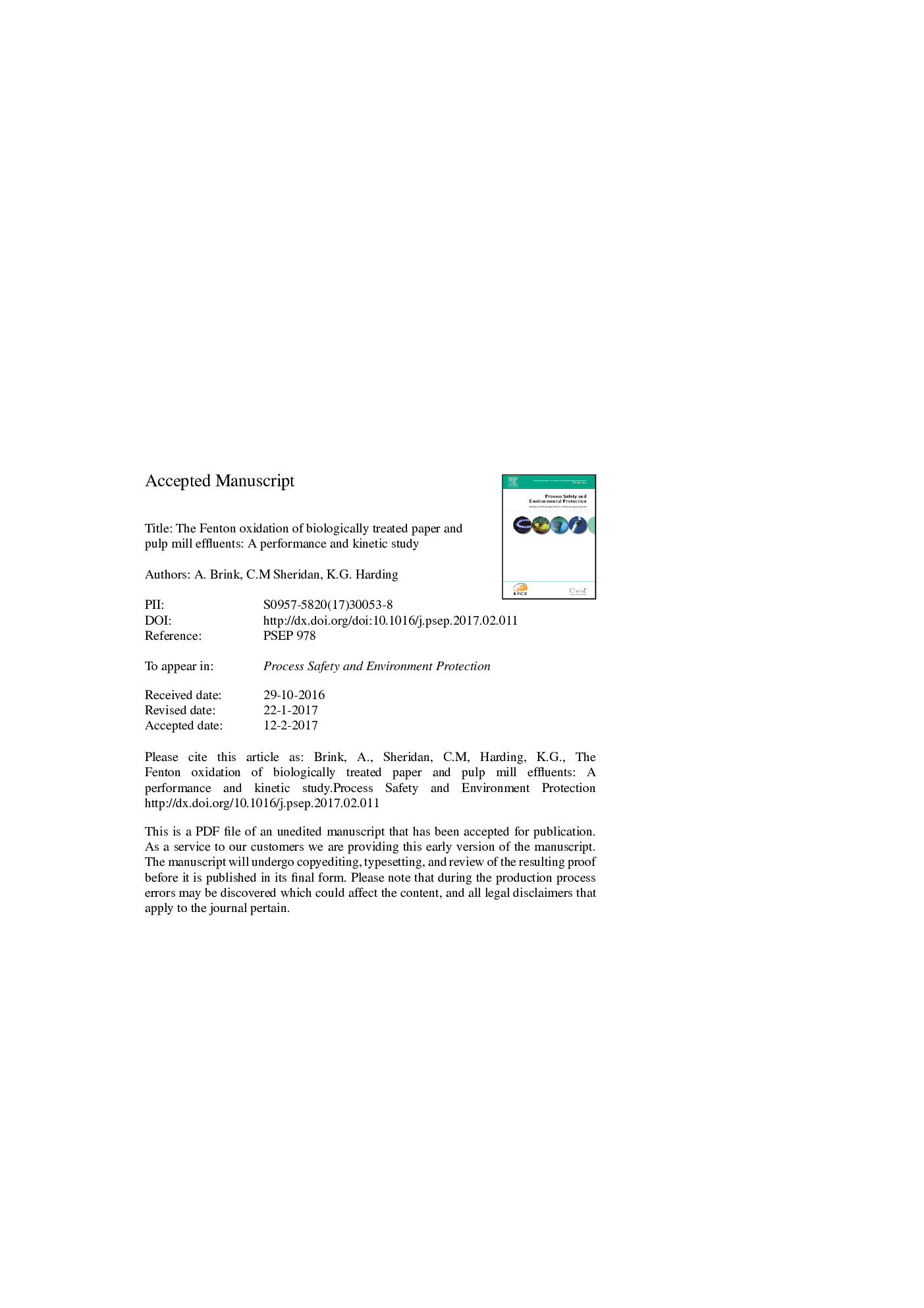| کد مقاله | کد نشریه | سال انتشار | مقاله انگلیسی | نسخه تمام متن |
|---|---|---|---|---|
| 4980983 | 1453333 | 2017 | 28 صفحه PDF | دانلود رایگان |
عنوان انگلیسی مقاله ISI
The Fenton oxidation of biologically treated paper and pulp mill effluents: A performance and kinetic study
ترجمه فارسی عنوان
اکسیداسیون فنتون از کاغذهای زیستی و پساب خمیر دندان: یک مطالعه عملکردی و جنبشی
دانلود مقاله + سفارش ترجمه
دانلود مقاله ISI انگلیسی
رایگان برای ایرانیان
کلمات کلیدی
فرآیند فنتون، فاضلاب بازیافت زباله، فاضلاب نیمه شیمیایی خنثی سولفیت، تقاضای اکسیژن شیمیایی، آلیاژهای بیولوژیک، سینتیک،
موضوعات مرتبط
مهندسی و علوم پایه
مهندسی شیمی
بهداشت و امنیت شیمی
چکیده انگلیسی
The Fenton oxidation (Fe2+/H2O2) of bio-recalcitrant organics, which are present in biologically treated paper and pulp mill effluents (BTME), were investigated in this study. This study primarily focused on the performance and kinetics involved in the Fenton oxidation of BTMEs. A biologically treated recycle mill effluent (RME) and a neutral sulfite semi-chemical (NSSC) mill effluent were used for the experiments. The impact of FeSO4·7H2O and H2O2 dosages on chemical oxygen demand removal (COD) was evaluated. The Fenton oxidation experiments were carried out at 25 °C and a pH value of 3.8. The initial COD of the biologically treated NSSC and RME effluents were 3756 mg/L and 436 mg/L, respectively. The maximum COD removal was found at a Fe2+/H2O2 ratio of 2.22 and 0.32 for the RME and NSSC effluents, respectively. The optimal COD/H2O2 for the RME and NSSC effluents was found to be 0.96 and 1.19 respectively. After a 60 min reaction, the maximum COD removal efficiency for the NSSC and RME effluents were found to be 44% and 63%, respectively. The maximum reaction rates obtained for the RME and NSSC effluents were 18 mg COD Lâ1 minâ1 and 48 mg COD Lâ1 minâ1, respectively. The experimental results demonstrated that bio-recalcitrant organics, such as phenols and lignin, were readily degraded into organic acids. The applicability of the first order, second order, Behnajady-Modirshahla-Ghanbery (BMG) and a newly developed two staged first-order (TSF) kinetic model were evaluated. Both the BMG and TSF models yielded high correlation coefficients (r2). For extended reaction times, it was found that the TSF model best described the COD removal. In addition, the TSF kinetic constants (k12, k13) revealed that a rapid initial degradation reaction is followed by a slower secondary degradation reaction. This performance and kinetic study demonstrated that the conventional Fenton process can effectively remove bio-recalcitrant organics that are found in BTMEs.
ناشر
Database: Elsevier - ScienceDirect (ساینس دایرکت)
Journal: Process Safety and Environmental Protection - Volume 107, April 2017, Pages 206-215
Journal: Process Safety and Environmental Protection - Volume 107, April 2017, Pages 206-215
نویسندگان
A. Brink, C.M Sheridan, K.G. Harding,
